Boeing B-29 Superfortress Assembly Plants, & Production Numbers
A total of 3,970 production B-29s were built, at these locations:
Prototypes |
Production |
|||||||
Aircraft Manufacturer |
Plant Location |
Plant Code |
XB-29 |
YB-29 |
B-29 |
B-29A |
B-29B |
Production B-29s Built |
| Boeing | Seattle, Washington | BO |
3 |
|||||
| Boeing | Renton, Washington | BN |
1,122 |
1,122 |
||||
| Boeing | Wichita, Kansas |
BW |
14 |
1,644 |
1,644 |
|||
| Bell Aircraft Co. | Atlanta (Marietta), Georgia |
BA |
357 |
311 |
668 |
|||
| Glenn L. Martin Co. | Omaha, Nebraska |
MO |
536 |
536 |
||||
TOTAL PRODUCTION
|
2,537 |
1,122 |
311 |
3,970 |
||||
The plant location was indicated in the data block on the left side of the fuselage below the pilot's window. Also contained the in the block number was information such as the model type and serial number.
Each plane was identified by a seven-digit serial number, with the first two digits indicated the fiscal year in which the Army Air Force ordered the plane, followed by a five-digit number unique to each aircraft.
The end of World War II in August 1945 dictated massive cancellations of existing orders for military equipment. In September of 1945, existing orders for over 5,000 additional B-29s were canceled.
Many of the existing B-29 aircraft were sent for storage, and ultimately scrapping at WWII aircraft storage and disposal facilities around the U.S. The remaining B-29s helped build the initial bomber inventory of the Strategic Air Command when it was formed in March of 1946.
Boeing Wichita Plant
The Early Years in Wichita: Stearman Aircraft
Lloyd Stearman, Walter Beech, and Clyde Cessna established the Travel Air Manufacturing Company in Wichita in January of 1925. Considered the big three aviation pioneers, they established the "air capital" and set the goal to manufacture "a plane for every purpose." Travel Air became the leader in light commercial aircraft.
Stearman left the company and the state in 1926 but returned the following year. He founded the Stearman Aircraft Corporation, which was acquired by a holding company for Boeing in 1929.
Stearman Aircraft Company, Wichita, Kansas, aerial view in the early years |
Stearman Aircraft Company factory & administration building, Wichita, Kansas, looking southwest, circa 1935 (Photo by the Wichita Chamber of Commerce) |
 |
Stearman Aircraft Company, Wichita, Kansas, South Oliver Street, showing completed biplanes in the foreground |
Stearman Merges with Boeing
The Stearman company signed its first major military contract in 1934, and built 61 Navy Model 73 biplane trainers.
In 1938 Stearman became a division of the Boeing company, and in 1941 the company became the Wichita Division of The Boeing Airplane Company.
Among its accomplishments in Wichita was the production of nearly 10,000 of its famous biplane trainers by 1945.
Building the New Boeing B-29 Plant in Wichita
Greetings from Wichita, Kansas |
Although it took 18 months to complete after its June 24, 1941 ground breaking, Boeing's new "Plant II" was in partial operation by June of 1942. New equipment was already being installed by Boeing six months before final completion.
Building a new plant was a formidable task, but staffing it with sufficient numbers of trained workers was equally difficult. Many of the employees from the local population had never before touched an airplane, and were totally inexperienced in aircraft fabrication and assembly.
People were recruited from all over Kansas and neighboring states. Accommodations for all of them needed to be found. A mammoth recruiting, training, and job placement task eventually created a skilled workforce.
Less obvious, but equally challenging, were the problems faced by the thousands of subcontractors that also had to expand and train their workforces across the country.
Production of B-29s at the Boeing Wichita Plant
The first production B-29s began to roll off the production lines at Boeing-Wichita in September of 1943.
Aerial view of the Boeing Plant, Wichita, Kansas, during World War II |
By mid-January 1944, 97 B-29s had been built by Wichita, but unfortunately only 16 of these were flyable. Only the very early Wichita-built models were delivered in olive drab and grey camouflage paint, with the remainder being delivered unpainted.
During March and April 1944, the intensive effort to get the first B-29s ready for overseas service became known as the "Battle of Kansas." All the B-29s used in the first raid on Japan on the steel center at Yawata, June 15, 1944, were built at Wichita.
At the end of the war Boeing-Wichita was producing 4.2 Superfortresses per working day for an average of 100 a month, which was the military's schedule. The plant had also reduced the number of manhours to produce a single B-29, from157,000 (the average required for the first 100 bombers), to less than 20,000.
When the war was won, uncompleted airframes on the Wichita assembly line were stripped of all government furnished equipment, and scrapped on the flightline.
Of the 3,888 Superfortresses built by all factories, 1,644 were Wichita-made. Wichita also built an additional 125 Superfortresses in spare parts. In later years, 1,370 Boeing B-47 Stratojets would be built in Wichita, as well as B-52 Superfortresses.
Boeing announced plans in January, 2012, to close its Wichita plant.
Boeing Wichita Plant, inside view of B-29s on the assembly line |
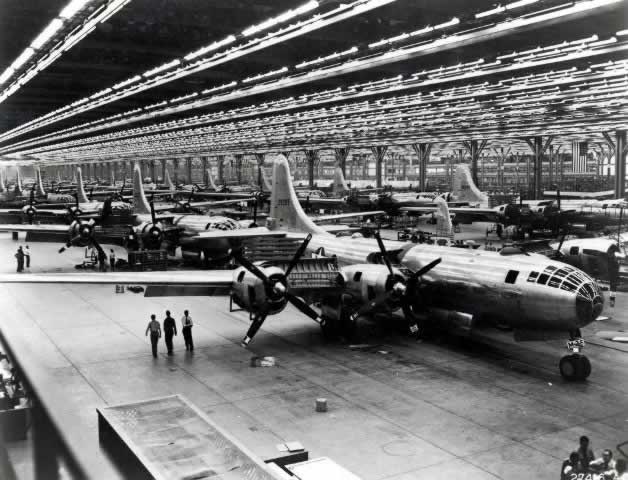 |
Inside the Boeing Wichita Kansas Plant, B-29 Superfortress assembly line |
 |
Boeing Wichita Plant, aerial view of completed B-29s parked on tarmac with part of the original Stearman Aircraft plant and water tower in the background |
Roll-out of the 1,000th B-29 Superfortress built at the Boeing Wichita Plant |
 |
Roll-out of a completed B-29 Superfortress, on the night shift, Boeing Wichita Plant |
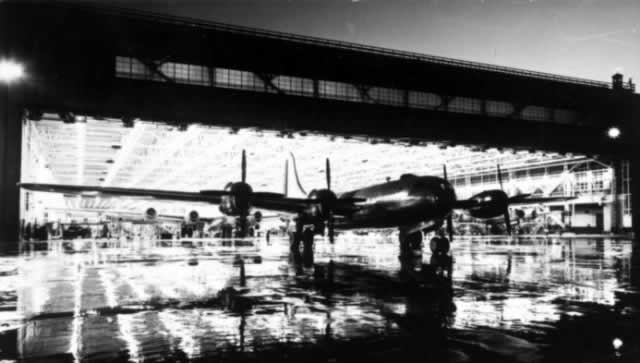 |
Boeing Wichita Plant, exterior view, with completed B-29s parked on tarmac |
 |
Boeing Wichita Plant, aerial view of completed B-29s, VJ Day, August 15, 1945 Notice the original Stearman Plant and water tower in the top-right of the photo |
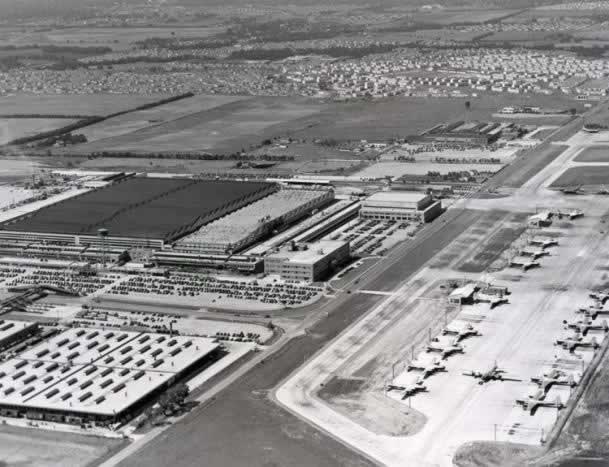 |
Martin Omaha (Bellevue) Plant
The Omaha area was yet another ideal aircraft manufacturing site, hundreds of miles inland, and safe from attack. Just south of Omaha was the town of Bellevue, the site of the new B-29 assembly plant, on the other side of the runway from present-day Offutt Air Force Base.
Glenn L. Martin Bomber Plant, Fort Crook, Nebraska |
The first aircraft assembly building built in Bellevue by the Glenn L. Martin Co. measured 600 by 900 feet with eight other major buildings supporting it.
There was over 250 miles of electrical wiring, 47,000 cubic yards of concrete, five acres of glass and 10-million square feet of painted walls. The plant had its own telephone system, bank, post office, hotel, library, recreation, police, school, fire and sanitation systems.
The first Martin-Omaha B-29 was delivered in mid-1944, and by 1945 over 13,000 employees were building the super bomber.
Among the B-29s built at the Bellevue Martin plant were the Enola Gay and Bockscar, the planes that dropped atomic bombs on the Japanese cities of Hiroshima and Nagasaki. On May 9, 1945, Col. Tibbets personally selected the B-29 that would become the Enola Gay on the production line at Omaha with the advice of plant foremen.
By the end of production, Martin-Omaha had constructed 536 B-29 Superfortresses. About 1,500 B-26 Marauders were also constructed at the Martin Omaha plant.
Boeing Renton Plant
Boeing began manufacturing operations in Renton, Washington in 1941 to build a reconnaissance aircraft for the United States Navy - the XPPB-1 Sea Ranger, an experimental flying boat. A site was chosen on the marshy shores of Lake Washington a few miles southeast of Seattle, on the Cedar River where, under Boeing supervision, the river was diverted and a 95-acre, 2.3 million square-foot (215,353 square-meter) plant was built.
By the end of production, Boeing Renton had constructed 1,122 B-29 Superfortresses. The last B-29 rolled off the Renton production line on May 28, 1946.
Bell Marietta (Atlanta) Plant
|
After the Japanese attack on Pearl Harbor on December 7, 1941, the Roosevelt administration decided to build additional aircraft-manufacturing facilities in the nation's interior, away from vulnerable coastlines. With its excellent railroad network and an established airport (Candler Field), the Atlanta area was an ideal location for new aircraft industries.
Based in Buffalo, New York, the Bell Aircraft Corporation had only about 1,000 employees when the United States entered World War II. About two weeks after Pearl Harbor, Bell learned that the government had selected its company to build B-29s in the Atlanta area.
The first B-29 rolled off the assembly line in February, 1944. Bell Bomber reached its peak employment of 28,158 workers in February 1945.
By the end of production, Bell Marietta had constructed 668 B-29 Superfortresses.
Bell-Marietta B-29 Superfortress assembly line |
 |
Night scene at Bell Bomber Plant, Marietta, Georgia, near Atlanta |
USAF B-29 Assembly Line Photos
Boeing B-29 Superfortress Assembly Line |
 |
Boeing B-29 Superfortress pressurized cockpit sections, showing connectors for pressurized tunnel over bomb bays |
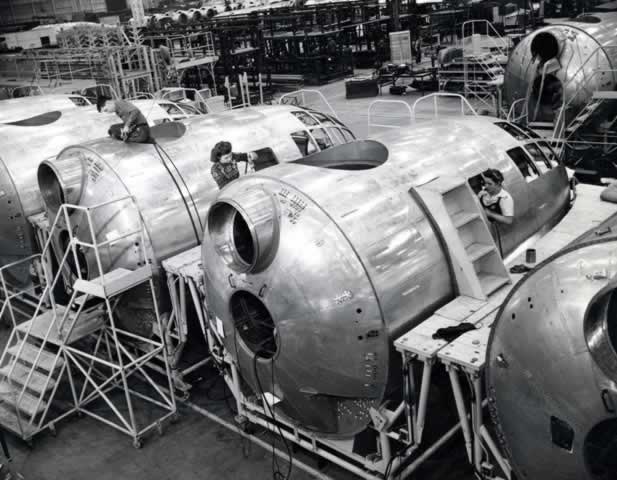 |
Partially completed wing assembly of the Boeing B-29 Superfortress |
Boeing B-29 Superfortress Assembly Line |
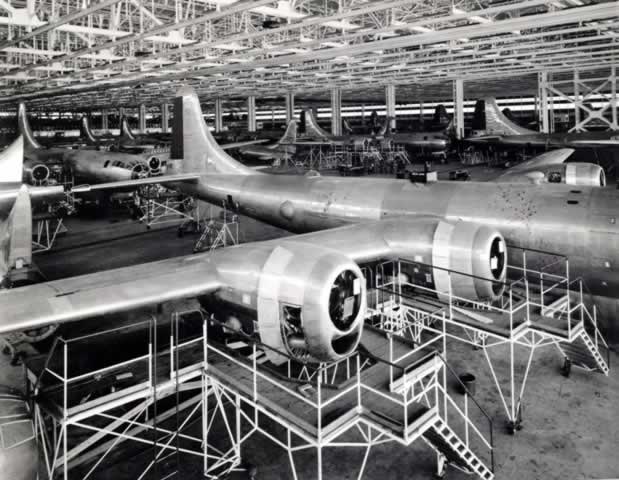 |
Boeing B-29 Superfortress Assembly Line |
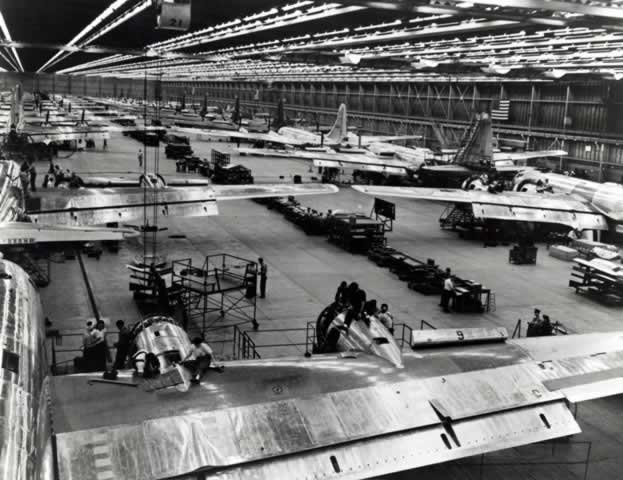 |
Boeing B-29 Superfortress Assembly Line |
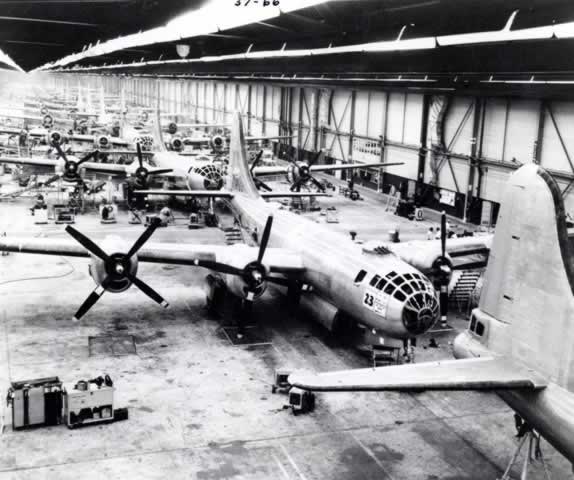 |
The completed aircraft: The Boeing B-29 Superfortress |
 |
Boeing B-29 Superfortress |
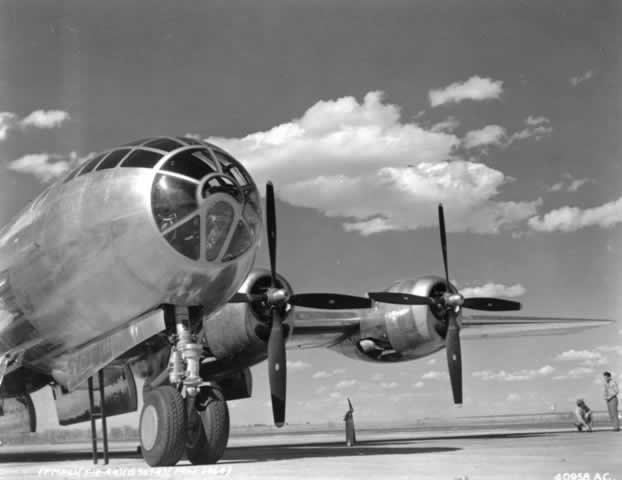 |
More about the B-29 Superfortress |
|||||

